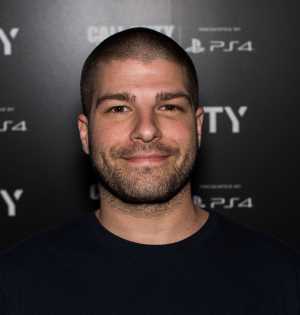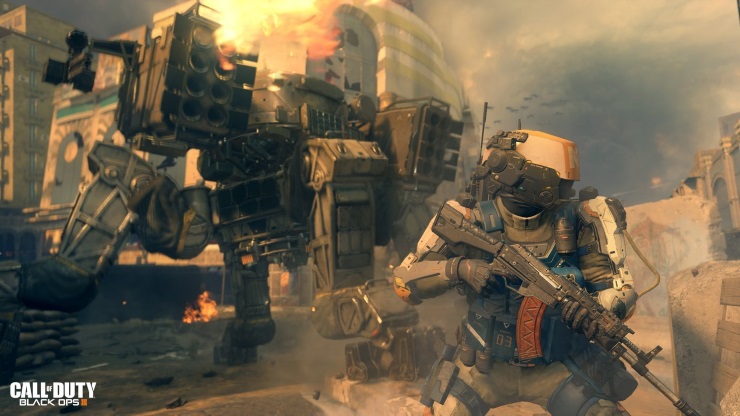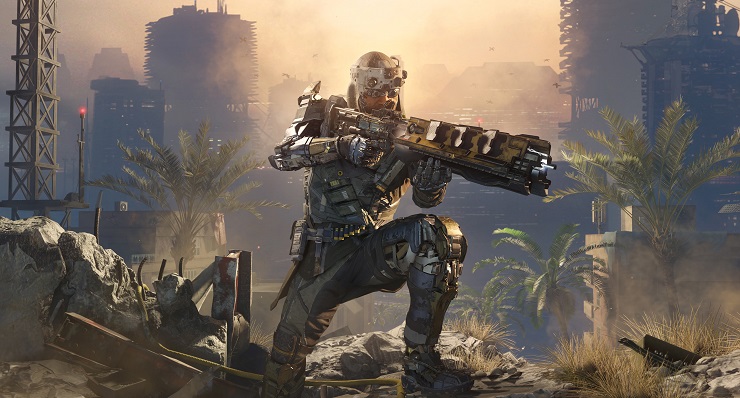As a fan of online multiplayer games and in particular shooters, it was a great privilege to get to speak with the Multiplayer Producer at Treyarch to talk about the upcoming Descent DLC for Black Ops 3. I only had a limited amount of time with him, but during that time we talked about the challenges of re-creating a fan favourite map from previous games, as well as the complexities of programming spawn locations and some of the opportunities for creating more imaginative themes for maps.
First up I asked him how the team went about creating the new map, Empire which is a re-imagining of Raid from Black Ops 2. In particular I was interested if the decision was purely based on fan feedback on certain maps, or whether choices were made because some earlier maps were better suited to the new style of gameplay in Black Ops 3 with the wall running and thrust jumping. “It sounds like it should be an easy choice”, he said, “however there are a number of factors we need to consider as we run a fine line between not ruining the original map and what made it so popular while also incorporating the new way that players approach the game now.”
 Interestingly, Miles confirmed that Raid is one of the top five most popular maps of all time across all of the Black Ops games, and of course that fan validation for each map has a significant amount of influence in choosing which to remaster. But he was also keen to explain that it wasn’t simply a case of picking a map that was popular, there were other considerations to take into account; the aesthetic of the original map is important, as is the flow of the engagements from one end of the map to the other. The new movement in Black Ops 3 has added different elements of verticality and has changed the way that encounters occur within the arena space. The challenge in re-designing a familiar map initially starts with taking the ideas to the extreme and from there working back to ensure that the freedom of movement and the ways that players can traverse the terrain are there, but also retaining what it is about the original map that made it so popular with players in the first place.
Interestingly, Miles confirmed that Raid is one of the top five most popular maps of all time across all of the Black Ops games, and of course that fan validation for each map has a significant amount of influence in choosing which to remaster. But he was also keen to explain that it wasn’t simply a case of picking a map that was popular, there were other considerations to take into account; the aesthetic of the original map is important, as is the flow of the engagements from one end of the map to the other. The new movement in Black Ops 3 has added different elements of verticality and has changed the way that encounters occur within the arena space. The challenge in re-designing a familiar map initially starts with taking the ideas to the extreme and from there working back to ensure that the freedom of movement and the ways that players can traverse the terrain are there, but also retaining what it is about the original map that made it so popular with players in the first place.
Moving on, I asked Miles about how the map design has changed over the years. In earlier games the maps were much bigger with wider, open spaces and the pace of the game was much slower. I mentioned Array and WMD in particular from the original Black Ops as examples of the standard of earlier maps. Has the reduction in the size of the maps been a conscious decision? “Oh absolutely, maps have got smaller as a conscious design decision based on player feedback. Our internal statistics show that players, in general, do not like the larger maps, they don’t like the longer range play”. Feedback from players suggested that they preferred the maps that forces engagement with other players much sooner, and that map design has evolved to incorporate that more and more. However, he acknowledges that not all players prefer the smaller maps so when designing the new arenas they try to create ones that contain a blend of elements that include longer range play as well as close quarters action, and he cited Hunted as an example of this where there are opportunities for medium to long range shots at various points in the map as well narrow areas for those keen on quick engagement.
We talked about some of the new maps coming up in the DLC pack and I asked if he had a favourite. He was cagey about answering saying “that’s like asking me to pick a favourite child”, but he was keen to stress that each map has unique elements to it that will appeal to different players. I was particularly interested in the map Berserk which is set in an ancient Viking village, and I asked how they came up with that concept. “We’re always looking for new ideas and themes” he said “and, we talked about how cool it would be to have a kind of Lord of the Rings, medieval type themed map, eventually settling on the ancient Vikings.” He then went on to talk about the research involved in looking at architecture of the Vikings and how that could lend itself to the design of the overall feel of the map and the movement. We also touched briefly on how the storyline within Black Ops 3 has enabled a more creative approach to the themes involved in the map design which means that an ancient Viking settlement isn’t out of place in a futuristic, science fiction based shooter, rather than being constrained by the theme of World War 2, for example.
One of the key questions I wanted to ask Miles about multiplayer design was the problem of spawn programming. How difficult is that to achieve and does the decrease in the size of the maps make this more challenging? Unsurprisingly he confirmed that the spawn algorithm is a constant challenge, but he said that issues with spawn may not even be a map problem. “There are a number of factors to consider; each player has a sphere of influence around them, and the spawn location needs to take into account not only if there is an enemy player nearby, but also if there is any equipment on the ground or what activity there is in the air.” He went on to explain that the team is constantly looking at the data to fix spawning issues and that feedback from angry players on forums and Twitter enables the team to understand a little more about how the spawn algorithm affects players experience with the game. It’s a constantly evolving issue, but he was proud to say that at present he believes Black Ops 3 has the best spawn calculations so far.

My time with Miles was wrapping up, so for my last question I asked him what a current Call of Duty game needs to do to be looked back on as fondly as Call of Duty 4 for example. It was a tough question, but he attempted to answer that by talking about what made Modern Warfare such a popular game in the first place; the freedom of create a class and the simple map designs that hid real complexity. For him, the challenge in creating a brilliant multiplayer game is to constantly experiment. The development cycle for a Treyarch game is three years and by the time their new game comes out there will have already been two more Call of Dutys, as well as a Titanfall, a Halo and whatever else is released beforehand. He finished the interview by explaining that his main focus is always on the core movement within the game, and balancing that so that the pacing is just right – “we want to give players awesome movement, but keep the pace slow enough so that all players enjoy the experience”.
We ran out of time in the end, so I didn’t get to ask him about how much influence games like Halo or Titanfall have had on Call of Duty going forward, and we didn’t even touch on the new Zombies map and the themes involved in that which was a shame, but what we did talk about was certainly interesting from a long time Call of Duty player’s perspective.
Descent is due for release first on PlayStation on July 12.






